Tekonsha Voyager Trailer Brake Controller w/ Custom Harness - 1 to 4 Axles - Proportional

 Arrives before Christmas
Arrives before Christmas 

with factory 4-Flat
with factory 7-Way
Will this fit?
To see if this custom-fit item will work for you please tell us what vehicle you'll use it with.
- All Info
- Reviews (751)
- Q & A (0)
- Videos (5)
- Photos
Tekonsha Trailer Brake Controller - TK32UR
- Electric
- Proportional Controller
- Up to 4 Axles
- Tekonsha
- Under-Dash
- Plug-In
- Under-Dash Box
- Single Trailer Only
- Indicator Lights
This proportional brake controller is designed to keep towing simple. Includes an LED braking indicator, a slide-bar manual override, and a knob to adjust braking power. Mounts easily within a 90-degree vertical range.
Features:
- Brake controller activates trailer brakes in proportion to your vehicle's braking action
- Automatically adjusts trailer's braking based on deceleration of tow vehicle
- Simple controls keep your settings within easy reach
- Gain setting lets you adjust the amount of power sent to the trailer's brakes
- Slide-bar manual override allows you to control trailer sway or stop in emergencies
- Sensitivity knob lets you set initial braking power and aggressiveness for smooth, safe braking
- Green LED on the top of the module monitors a secure connection with trailer
- Glows red to indicate that trailer brakes are being activated
- Quick and easy installation with included bracket and hardware
- 90-Degree vertical mounting range - must be horizontally level and parallel to direction of travel
- No need to wire into your vehicle - custom-fit harness lets you plug in and go
Specs:
- Application: trailers with up to 4 axles (8 brake assemblies)
- Compatible with electric brakes only
- Dimensions: 5" long x 3" wide x 1-1/2" tall
- Mounting: between -20 degrees and 70 degrees in the vertical plane
- Warranty:
- Limited 5-year on brake controller
- Limited 1-year on wiring harness
Power and Sensitivity Adjustment
Once the brake controller is installed, you can use the knob on the right side of the unit to adjust the gain (also known as output). Gain lets you set the maximum amount of power that will be applied to your trailer's brakes. You want to set it as high as you can without locking up the brakes. Typically, this setting is only readjusted when you experience changing road conditions or if you switch over from a heavy, loaded trailer to a much lighter, empty trailer, or vice versa.
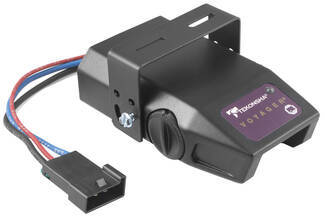
You can fine-tune the gain by adjusting the sensitivity of the internal sensor using the knob on the left side. This controls the aggressiveness of your trailer's braking, meaning how quickly the brakes reach the maximum braking level. You can adjust this when you're towing heavy loads and you need more umph to bring your trailer to a stop. Your tow vehicle doesn't need that much power to brake in time, but your heavy trailer does. A high sensitivity level will get the braking power to your trailer brakes faster and with more intensity so that it doesn't push your tow vehicle forward.
LED Indicator
Keeping with its simple design, the Voyager will not overwhelm you with information. An LED indicator on the top of the unit lights up green to show that your trailer is securely connected to your tow vehicle. The LED indicator will change to red when the brakes on your trailer are activated.
During installation and setup, this light is also used to ensure that the Voyager will be able to function correctly. Proper leveling of the internal sensor is crucial to the operation of this brake controller. When the sensor is level, the LED will change to a shade of orange.
Simple Installation
The Voyager is designed to be mounted in your cab at a vertical angle that is between -20 degrees and 70 degrees. The brake controller needs to be horizontally level and parallel to the direction of travel in order to function properly.


To connect the Voyager, just plug the included harness into your vehicle. The other end plugs into the controller - no hardwiring required.
Once the controller is mounted and connected, you must level the internal sensor. First, set the overall power to the maximum using the knob on the side of the controller. Then, while pressing the tow vehicle's brake pedal, adjust the level knob on the other side of the brake controller (this is the same knob that is used to fine-tune the power output) until the LED monitor is a shade of orange.
Note: If you don't already have a 7-way plug at the back of your vehicle, take a look at our exclusive 7- and 4-way brake controller installation kit (ETBC7 - sold separately).
Proportional Braking
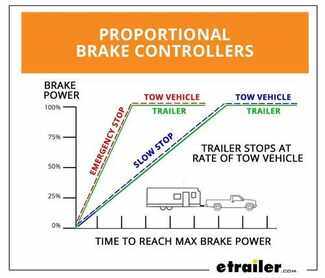
The Tekonsha Voyager brake controller comes equipped with proportional braking to give you the best towing experience. Proportional braking means that your trailer brakes mimic your tow vehicle's brakes. If you slam on the brakes in your vehicle, your trailer brakes will activate with the same intensity; if you brake lightly, your trailer brakes lightly too. The trailer's braking is in proportion to your vehicle's braking. This saves wear and tear on the tires and the brakes on both your vehicle and trailer.
The Voyager uses a pendulum system to sense how your vehicle is braking so it can send the right amount of braking power to your trailer. It measures the inertia of your tow vehicle and activates the trailer's brakes to slow at the same rate. The result is uniform braking across your towing setup. No push-pull action - just smooth, proportional braking every time.
9030 Tekonsha Voyager Electric Brake Controller - 1 to 4 Axles - Proportional
303500 Tekonsha Brake Control Wiring Adapter with 2 Plugs
Replaces Tekonsha 3035 and Tow Ready 20260
Installation DetailsCalifornia residents: click here

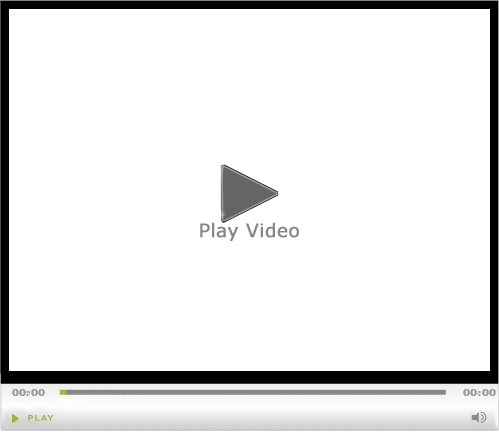
Videos are provided as a guide only. Refer to manufacturer installation instructions and specs for complete information.
Video Transcript for Installation: Tekonsha Plug-In Wiring Adapter for Electric Brake Controllers on a 2004 Ford Explorer
Today on this 2004 Ford Explorer we're going to install part number ETBC7 We're going to use this to install Brake Controller part number 90885 from Tekonsha, the Prodigy P2 Brake Control. So we'll start off our install by installing a mounting bracket onto the hitch. Now this bracket does not come with the kit and we'll be using part number 18140. Now the bracket is a little on the short side, so we have to make it a little bit longer. What we're going to do is just add a couple more holes to the end of the bracket.
We use a 7 pole bracket to locate our holes. Then we'll go ahead and drill it out and then attach it to our 7-pole bracket. Then we'll attach it to our hitch. Before we install our 7-pole connector we'll go ahead and take a few moments to connect our gray wire that comes with the kit up to our 7 pole connector. What we'll do is wind these wires up in electric tape and leave out the leads that we'll need later, such as the 4-pole, the brake wire, which is blue and our black wire which is for our 12 volt power supply.
Then we'll wrap up our purple and white wire. The white wire will be attached to the frame for ground while the purple wire is for reverse lights if it is ever needed. Onto our black and blue wires. We'll install the gray duplex cable, which has a black and white wire. We'll peel away the gray sheet to reveal the wires and strip them back to make our connections.
We'll go black to black and then white to blue. We'll put some tape around those connectors, as well. Next we'll install the loom around the wires like this and then tape it up. With our 7-pole connector installed onto the bracket we'll turn attention to the 4-pole. Now we'll have to remove the original 4-pole from its original bracket right behind the hitch and we'll go ahead and make our connection.
To make the 4-poles go together we're going to cut the sheath off the adapter side and then we can plug into the factory 4-pole harness. Apply a little bit of electric grease on the inside to protect the connections and make it a permanent connection after that. With our 4-pole connected up we'll go ahead and run our white wire with a ring terminal tot he body for ground. We'll be using a number 14 self-tapping screw to accomplish this. Then we'll go ahead and take our gray cable and run it up to the front of the vehicle. We'll make sure we'll stay away from anything that's moving, like the suspension, or anything hot, like the exhaust. We'll go ahead and route this cable up through the engine compartment up to the battery. At this point we'll go ahead and install the circuit breaker. With the cable ran up to the battery we'll go ahead and run it past a little bit, maybe about 3 to 4 foot and then cut off the excess. Our black wire in its sheath is going to be connected to the circuit breaker and then ran to the positive post of the battery. When we run our black wire through the circuit breaker we'll run it from the end going out from the 7-pole, we'll run it up to the silver post. Then the copper post will go to our positive power supply. In this case we're going to actually tap off the power supply going into the power junction box. And the white wire's going to be, actually, ran back underneath the vehicle and up through a grommet to get to the inside. We'll cut the grommet from the inside underneath the dashboard and then use a piece of air tube to stick through it to the outside towards the engine compartment. We'll go back outside and pull the air tube up and connect it through our white wire with some electric tape, then pull it back into the vehicle from the inside. Next we'll route a piece of air tube over to the passenger side glove compartment, which we've lowered out of the way to get to our tow package. We'll go ahead and plug in our wiring harness to the port, which is part number 3035-P. Then we'll attach the other end to our air tube and pull it back over to the driver's side. When we have the cable ran to the driver's side we go ahead and start mounting the brake controller. When we install a bracket we'll make sure that it makes the brake controller sit in a straight line with the vehicle. We use two screws attached to the dash and then we'll go ahead and plug into the back of the brake control. Now since the tow package isn't complete, which means that the blue wire on the port isn't ran all the way out back and that's ran I ran a white wire to the inside, we'll cut the blue wire--that will be the output from the brake controller--and we'll splice that into our white wire right behind the brake controller. Then we'll go ahead and run two other screws into the side of the brake controller to hold it in place. And after a quick check with our trailer to verify the connectivity, now finish it before I install ETBC7 on our 2004 Ford Explorer.
Customer Satisfaction Score:
98% were satisfied with this product
2% of customers were not satisfied
- Product did not meet expectations
Ratings & Reviews
4.8
750 reviews
See what our Experts say about this Tekonsha Trailer Brake Controller
- Most Economical Trailer Hitch Receiver and Wiring Harness For a 2023 Honda Pilot TouringOur etrailer Trailer Hitch Receiver # e27KR you found is our most economical custom fit receiver for your 2023 Honda Pilot Touring edition. For the wiring you can select from either the 4-Way # C48ZV or the 7-Way # C35ZV depending on the types of trailers you will be towing. If you have a trailer with a 7-way you are also most likely going to need a Trailer Brake Controller # 39510 along with the Wiring # 20127 to connect it. This is one of our most economical and reliable proportional...
view full answer... - Should Blue Wire From Brake Controller Have Constant PowerThe blue wire coming from the back of your Tekonsha Voyager Brake Controller # 39510 is for brake output to the 7-Way connector. This wire should only have power with the brake pedal depressed or the manual override activated on the brake controller. If you are getting constant power on this blue wire this may be an indication that the controller is bad but there is an easy way to test this. You will want to first sever the blue wire several inches from the back of the controller. Then...
view full answer... - Is Reese Voyager and Tekonsha Voyager the Same Brake ControllerThey are the same controller as Reese and Tekonsha are made by the same company. The Tekonsha part # 39510 does not come with the vehicle specific install harness part # 3035-P which is custom fit for your 2003 Ford F-250/350.
view full answer... - Tekonsha Voyager Brake Controller Not Activating Trailer Brakes When Brake Pedal Is PressedYes, we can help you test your brake controller and determine if the controller is bad or if there is a wiring issue that is causing the problem on your 2003 Ford F-250 pickup. Lets start with the easiest things first. Be sure that when you are testing the trailer brakes with the brake pedal that the vehicle is moving. The trailer brakes will not apply with the brake pedal if the vehicle is not moving because of the proportional sensor. The first thing I would check is the red wire that...
view full answer... - Troubleshooting No Green Light on Tekonsha Voyager Brake ControllerThe green light on top of your Tekonsha Voyager Trailer Brake Controller # 39510 indicates that a trailer is connected to your vehicle. If this light is not turning on when connected to a trailer there are a couple things, you can check. I first recommend inspecting both the vehicle side and trailer side connectors for any debris or corrosion built-up around the pins that needs to be cleaned out. If the connectors look good, you will next want to test the brake output pin on the vehicle...
view full answer... - Trailer Brakes Do Not Activate With Brake Pedal When Trailer is Sitting StillActually that is a possibility. Proportional brake controllers will not engage the brakes with the pedal unless the tow vehicle is in motion. Another possibility is the red wire from the brake controller isn't connected correctly. It needs to be connected to the cold side of the stop light switch or the wire that is hot only when the brake pedal is pressed. I would also check any fuses related to towing and replace if necessary. If none of these ideas solves your problem let me know...
view full answer... - Fuse Location to Power an Electric Trailer Brake Controller on a 2005 Chevy SilveradoThe Tekonsha Voyager Brake Controller with GM Wiring Harness, # 39510 and # 3015-P, itself does not have a fuse. Since it is connected to the truck via the factory port under the dash, the fuse for the brake controller 12 volt power is located in the power distribution box under the hood. We actually have an FAQ article that explains the installation of a brake controller Chevy and GMC trucks that includes your 2005 Silverado. It covers the connections that need to be made under the hood...
view full answer... - Which Harness to Install Tekonsha Voyager in 2019 Ram 1500 ClassicWhat brand and model is the brake controller? The Rams changed quite a bit in 2015 so a new harness would be needed. But if you can get me the controller you have I can help pick you out what you'd need.
view full answer... - Recommended Wiring for 1998 Ford F-150 to Add 7-Way to Factory 4-Way Trailer ConnectionFor your 1998 Ford F-150 Extended Cab with factory 4-way flat, you need the Tekonsha Ford Replacement OEM Tow Package Wiring Harness, 7-Way # 118242. This will give you the two additional relays needed as well as the wiring harness. Then you will need a brake controller. I recommend the Tekonsha Prodigy P3 # 90195 as well as the wiring adapter # 3035-P. This will give you an easy to use proportional brake controller with easy to use presets as well as a nice LCD screen for diagnostics....
view full answer... - Troubleshooting a Tekonsha Voyager Brake ControllerHey Scott! You're going to need to connect a trailer to your vehicle. You're not going to know what's working correctly or incorrectly on the Tekonsha Voyager item # TK29ER unless you hook a trailer up. If you run into any problems down the road feel free to comment below or email me directly and I'll be happy to walk through them with you.
view full answer... - What Are the Brake Controller Wire Colors for on a 1998 Dodge Ram 2500The factory electric trailer brake controller wires on a 1998 Dodge Ram 2500 are as follows: Power - Red/Orange Ground - Black/Orange Stop Light - White/Tan Brake Output - Light Blue For a brake controller, I recommend using the Tekonsha Voyager Trailer Brake Controller part # 39510. It sounds like the previous owner of your truck may have cut off the old brake controller port so you are also going to want to use the Replacement Brake Control Plug-In Harness for Tekonsha and Draw-Tite...
view full answer... - Troubleshooting Vehicle that Won't Start After Brake Controller InstallWithout knowing what truck you have it's hard for me to know if you have the correct harness. I will say that the problems you are describing are unlike any problems we have ever seen from installing a brake controller. If removing the brake controller makes the problems go away then I would strongly recommend you do so until you figure out why this problem is occurring. Make sure you have your truck shifted into park or neutral before you attempt to start it. You may have moved the shifter...
view full answer... - Where is the Brake Controller Plug In Located on a 2011 Ford F-250 Super DutyOn the 2011 Ford F-250 Super Duty, the brake controller port is located behind the center dashboard access panel on the passenger's side. One end of the # 3034-P adapter will plug into the back of the brake controller and the other end plugs into the brake controller port on your vehicle. If your vehicle has the factory 7-Way connector on the rear of your vehicle, then all of the wires for the brake controller have already been run. If you have a factory 4-Way connector on your vehicle...
view full answer... - Troubleshooting Voyager Trailer Brake Controller Not Working when Brake Pedal is PressedIt is possible that either the connection to the brake switch is no longer good enough to provide an adequate signal to the brake controller and a new connection will need to be made, or there is a short or possibly a bad ground causing the problem. You may want to also check the stoplight fuse. A blown fuse will not allow the signal to get through and the brake controller will not know you are stepping on the brakes. You can find the fuse by checking your owners manual which should have...
view full answer... - Troubleshooting LED Indicator Light on Tekonsha Voyager Brake Controller 39510The green light on the Voyager brake controller # 39510 should come on as soon as you plug the trailer into the vehicle. If it does not come on at all, this indicates that you either have some corrosion inside the trailer or vehicle plugs that is causing a short, or you have a loose power or ground connection. Check the plugs on both sides of the setup for any white or green corrosion. If you see any, clean the plug thoroughly or just replace it. If you don't see any buildup in either...
view full answer... - How to Find the Brake Wire on a 2001 Toyota Tacoma for Brake Controller InstallWhen we installed a brake controller in a very similar Toyota Tacoma as your (see attached install video), we found that the correct wire to use for the stoplight switch was dark green wire with a white stripe. You should still test this wire for voltage with the circuit tester to verify it is the correct one. But this would be an excellent starting point.
view full answer... - Recommended Brake Controller for a 2018 Thor Ace MotorhomeFor your 2018 Thor Ace Motorhome, I recommend using the Curt Spectrum Trailer Brake Controller part # C51170. The reason for this is because this unit is composed of two main parts, the control box and the output knob. The control box gets mounted out of site and then the output knob will get installed up on your dash for easy use and a very aesthetically pleasing look. The color output of the knob also helps with ease of use. Since your motorhome is on a Ford F-53 chassis, you can use...
view full answer... - Casita Travel Trailer With Repeated Issues On Left Side Of Axle OnlyHello Paul. It sounds like you have an axle, or axle mounts that are out of alignment. That is really the only explanation since the issue has been reoccurring even after several replacements. I wonder if the 1st axle sustained damage of some sort which bent the mounts. This would explain the bearings overheating also. At this point I suggest you take your camper to a shop and have them check the alignment of the axles and the mounts.
view full answer... - Troubleshooting A Tekonsha Voyager Brake Controller That Isn't Sensing The TrailerHi Howard, Typically if the Tekonsha Voyager Trailer Brake Controller # 39510 isn't detecting the trailer it's just an issue with the trailer connectors not making a solid connection. Check the pins on your trailer connector to see if they're corroded, damaged, bent, or dirty. A lot of the time the pins get bent back from connecting to the 7-way socket on the vehicle over and over and just need to be bent back into place with a thin flathead screwdriver so that they contact the pins in...
view full answer... - What To Do if an RV Dealership Installs a Brake Controller Incorrectly and Damages Cruise ControlIt sounds like the RV dealership that installed your Tekonsha Voyager Brake Controller part # 39510 did not install the controller correctly initially, and even though he attempted to rewire the controller the damage was done to your vehicle and now you have lost cruise control. I would recommend having the mechanic look at the circuits like you are doing, and then once they confirm that the initial install of the controller screwed up your cruise control circuit I would go back to the...
view full answer... - Correct Brake Controller Adapter for 2011 Ford F-150If you have one of the following brake controllers, we offer a complete plug-in application. No wiring needed, just plug one end of the Tow Ready Plug-In Wiring Adapter, # 22292, into your brake controller and the other end will plug into the built-in harness beneath the dash on your 2011 Ford F-150. Brake EVN # TK63VR Tekonsha PowerTrac # 39523 Tekonsha P2 # 90885 Tekonsha P3 # 90195 Tekonsha Primus IQ # TK90160 Tekonsha Voyager # 39510 If you have a different brand of brake controller,...
view full answer... - What Hitch do You Recommend for My 2022 Subaru Forester?Definitely! The main factors that determine the hitch are hitch receiver opening size (either 1-1/4" or 2"), weight capacity offered, and how the hitch installs on your vehicle. For example, if you are looking for a hitch that is compatible with most accessories and provides you with the most weight capacity, I recommend going with a 2" hitch like the Curt Hitch - 2" # C13409. Not only does this hitch provide you with the most weight capacity we offer for your vehicle (525 maximum tongue...
view full answer... - No Power to Brake Controller on a 2005 Chevy SilveradoIt sounds like you will need to make some connections under the hood to make everything fully functional and get power to the brake controller. Wiring harness # 3015-P is correct for your 2005 Chevy Silverado and it sounds like you have all the wires in the right place in it so it must be the connections under the hood. I have included a link to our help article that explains the connections under the hood, among other things, to get everything on the truck working. Specifically you will...
view full answer... - Blue Wire Showing Voltage with No Trailer Connected and When Not Applying Brakes on Brake ControllerIt does sound like there is a short to the brake controller through the wiring or in the internal circuitry of the brake controller. Since your brake controller shows no red light this indicates a short to the brake line (blue wire). If you are using wiring harness, # 3040-P, make sure that extra white ground wire is attached to a clean bare metal surface. If it is hardwired to the truck, the ground needs to be connected to the negative battery terminal. Sever the blue wire a few inches...
view full answer... - Which Brake Controller Install Harness Fits 2022 Ford E-450 CutawayFor your 2022 Ford E-450 cutaway chassis the correct Tekonsha brake controller install harness is actually the part # 22292. This is why what you have doesn't look like it would work with the 3035-P.
view full answer... - Below Bed 5th Wheel Installation Kit Needed For A 2000 Ford F-250 Hey Judah, For below bed you would need to go with the B&W Turnoverball Underbed Gooseneck Trailer Hitch # BWGNRK1108 and then use either the fixed base Companion # BWRVK3500 or slider base Companion # BWRVK3400-5W depending on whether you have a long bed or short bed. If your bed is less than 8' then you'll want to go with the slider base to gain some additional turning clearance when making tight turns. This setup would also allow you to tow gooseneck trailers but removing the hitch...
view full answer... - Recommended 7-Way Trailer Wiring On 2007 Ford E-350 Super Duty VanIf you don't already have a 4-way wiring harness, we need to start there to get your 7-way. For a 4-way, I recommend the Curt T-Connector Vehicle Wiring Harness with 4-Pole Flat Trailer Connector # C56020 which plugs in behind the tail lights of your 2007 E350. You will have to remove the tail light assemblies and interior trim paneling to access the factory connections. I've attached a video to help. Then you will use the Universal Installation Kit for Trailer Brake Controller - 7-Way...
view full answer... - Brake Controller Wiring for Ford E-450 MotorhomeIf your vehicle has a factory brake controller plug, you can simply use the Tekonsha Plug-In Wiring Adapter for Electric Brake Controllers – Ford, Item # 3034-P, which will connect to the vehicle plug and the brake controller. On the new E-450 vehicles, the plug is located behind the storage compartment above the radio. Once you remove the storage compartment, you can plug in the adapter and run the cord behind your dash to the brake controller. I've attached several images showing where...
view full answer... - Is Reese Voyager and Tekonsha Voyager the Same Brake ControllerThey are the same controller as Reese and Tekonsha are made by the same company. The Tekonsha part # 39510 does not come with the vehicle specific install harness part # 3035-P which is custom fit for your 2003 Ford F-250/350.
view full answer... - Tekonsha Voyager Brake Controller Not Activating Trailer Brakes When Brake Pedal Is PressedYes, we can help you test your brake controller and determine if the controller is bad or if there is a wiring issue that is causing the problem on your 2003 Ford F-250 pickup. Lets start with the easiest things first. Be sure that when you are testing the trailer brakes with the brake pedal that the vehicle is moving. The trailer brakes will not apply with the brake pedal if the vehicle is not moving because of the proportional sensor. The first thing I would check is the red wire that...
view full answer... - Brake Controller Plug Location on a Class C Motor Home Built on a Ford E-450 ChassisI spoke with my contact at Tekonsha and he informed that you are looking for a brown 6 pin connector behind the hood release, up near the firewall to plug in the Tekonsha Plug-In Wiring Adapter # 3035-P. He said there is also a gray connector that is very similar to the brown connector that the # 3035-P will actually plug into but it is not the correct one to use. The Tekonsha Prodigy P2 Proportional Brake Controller # 90885 and the # 3035-P Ford Super Duty Adapter is what you need.
view full answer... - Where is Brake Controller Install Port for 2018 Ford ExplorerTo install your Reese Pod brake controller in your 2018 Ford Explorer will require the install harness part # 3035-P which is a confirmed fit. If you check out the 9:55 mark of the install video I attached to this page you'll see where to find the port on your vehicle to plug the controller in. It is a bit hidden under the dash underneath the panels.
view full answer... - Parts Needed To Install a 7-Way and Trailer Brake Controller On a 1996 Ford F-350 With Factory 4-WaySince you already have a factory 4-way flat on your 1996 Ford F-350 you will need the Adapter 4-Pole to 7-Pole # 37185. This will plug into your factory 4-way and the rest of the wiring will have to be spliced into your factory wiring as I do not see anyone makes wiring for your factory connectors. The Tekonsha Plug-In Wiring Adapter # 3035-P will allow you to plug into the 6 pin connector you found under the dash. Then you can connect the Tekonsha Prodigy P3 Trailer Brake Controller # 90195.
view full answer... - Installing A Reese Brakeman Controller In A 202 Ford E250 With Factory 4-FlatHey John, I can definitely help with that. The Reese brakeman controllers are compatible with the Tekonsha brand plug-and-play adapters. For your 2002 Ford E250 you can use the # 3035-P to plug directly in to the factory brake controller plug. You will also need item # 37185 to complete your wiring. The brake (blue) wire will need to be run from the brake controller back to the plug in the rear. The brake controller power and brake pedal wires are already run. A 12 volt hot lead from the...
view full answer... - Brake Controller Recommendation for a 2008 Ford F-150 with Factory 4-WayTo install a brake controller in your 2008 Ford F-150 you would be able to use the brake controller port under the dash and you will need to complete the wiring at the rear of your vehicle to the 7-way at the rear of the truck. For a brake controller I would recommend the Prodigy P2 Brake Controller part # 90885. This is our best selling brake controller because of how well it works and how easy it is to setup. This is a proportional brake controller that senses the amount of braking the...
view full answer... - Brake Controller Connector Location on a 2020 Ford ExplorerIf your 2020 Explorer is equipped with the factory 7-way trailer connector, it will have the brake controller connector under the dash. The connector is located under the dash, above and to the right of where the driver's right knee would be. The connector will be rectangular, and will be gray in color. If you use a Tekonsha brake controller like the Tekonsha Primus, part # TK90160, the # 3035-P wiring adapter is the correct harness. If the vehicle doesn't have the factory 7-way, the connector...
view full answer... - Recommended Wiring for 1998 Ford F-150 to Add 7-Way to Factory 4-Way Trailer ConnectionFor your 1998 Ford F-150 Extended Cab with factory 4-way flat, you need the Tekonsha Ford Replacement OEM Tow Package Wiring Harness, 7-Way # 118242. This will give you the two additional relays needed as well as the wiring harness. Then you will need a brake controller. I recommend the Tekonsha Prodigy P3 # 90195 as well as the wiring adapter # 3035-P. This will give you an easy to use proportional brake controller with easy to use presets as well as a nice LCD screen for diagnostics....
view full answer... - Factory Brake Controller Harness Location on a 2013 Ford ExplorerThe harness for the 2013 Ford Explorer is located above and behind the hood release lever. There will be a 6-pin connector that mates with the one on the adapter at the end of the harness # 3035-P. For a brake controller i recommend the Tekonsha P2, # 90885, because it is one of our best selling controllers for its ease of use. I have included a link to the installation details for you to view.
view full answer... - Brake Controller Wiring Harness Location on a 2013 Ford Explorer LimitedOn your 2013 Ford Explorer Limited, the factory brake control wiring harness should be located above and behind the hood release under the dash on the drivers side. To connect your P2 brake controller to the harness, you will need the Tekonsha Plug-In Wiring Adapter, # 3035-P. This adapter has one end that plugs into your P2 brake controller and a larger end that plugs into the 6 pin connector that should be located behind the glove box on the vehicles brake control harness. I have attached...
view full answer... - How Would EZ Connector Magnetic 7-Way Trailer Connectors with Built-in Seal # 319-R7-02 InstallIf your 1994 Ford F-150 has a 7-way installed on it already the EZ Connector Magnetic 7-Way Trailer Connectors with Built-in Seal # 319-R7-02 will easily plug in line with it once you remove the 7-way from your truck's wiring and then plug this in place. Then on the trailer side you have to remove your current 7-way and then wire the trailer side connector in it's place.
view full answer... - Recommended Brake Controller for a 2018 Thor Ace MotorhomeFor your 2018 Thor Ace Motorhome, I recommend using the Curt Spectrum Trailer Brake Controller part # C51170. The reason for this is because this unit is composed of two main parts, the control box and the output knob. The control box gets mounted out of site and then the output knob will get installed up on your dash for easy use and a very aesthetically pleasing look. The color output of the knob also helps with ease of use. Since your motorhome is on a Ford F-53 chassis, you can use...
view full answer... - Why Is the Tekonsha Prodigy P2 Blowing a Fuse in My 2006 Ford Van when I Plug it in?Hello Bry, I am sorry the Prodigy P2 keeps popping a fuse, let's see if we can get you in good working order. You're dealing with a fuse that keeps blowing whenever you plug in your Tekonsha Prodigy P2 brake controller # 90885 in your 2006 Ford van (that was the vehicle in the fitguide). This usually points to a short somewhere in the wiring, most often with the black wire that supplies 12V power to the controller. If that wire is pinched or the insulation is damaged especially where...
view full answer... - Recommended Brake Controller and Wiring Harness For 2005 Holiday Rambler Ambassador on F53 ChassisFor your 2005 Holiday Rambler Ambassador motorhome, I recommend you use the Tekonsha Prodigy P3 Brake Controller # 90195. This controller utilizes a LCD screen that gives you easy to read and understand diagnostics and comes with simple presets to make set-up easy. It is proportional, so it will allow you to apply the trailer brakes at the same time and with the same amount of pressure so your trailer doesn't end up pushing or pulling your RV. It doesn't have the codes of most brake...
view full answer... - Recommended Plug in Brake Controller Adapter for a 2016 Range Rover TD6Hey Patrick! I would love to give you a quick yes but the best I can do is maybe and then show you what you need to look for. There is conflicting information on Tekonsha's website that says your 2016 Range Rover TD6 has the brake controller adapter port but I can tell you exactly where to look to find it. I linked a diagram below that shows the wiring on your Range Rover. This will be at the base of the left side a-pillar or to the left of your left foot right before your driver's side...
view full answer... - 2001 Ford F-150 Trailer Hitch Needed with a 700 lbs Tongue Weight and Fits with Spare TireThe Draw-Tite Trailer Hitch Receiver # 37130 is a Class IV trailer hitch with a 2" receiver opening that is confirmed to fit your 2001 Ford F-150 and will allow you to keep your full spare in it's current location. This has a 7,000 lbs Gross Towing Weight (GTW) rating and a 700 lbs Tongue Weight (TW) rating. When used in conjunction with a Weight Distribution (WD) system those ratings are bumped up to 12,000 lbs GTW and 1,200 lbs TW. I have attached the installation details for you to...
view full answer... - What Vehicle Specific Pigtail do I Need for My Tekonsha P3 for My 2001 Ford F-350, Mounting Bracket?Hello Kip, Nice choice on brake controller, definitely my go to! For your 2001 Ford F-350 you will want the Tekonsha Plug-In Wiring Adapter for Electric Brake Controllers - Ford, Lincoln, Mercury # 3035-P. For the bracket it comes in 2 pieces, the part that attaches the brake controller # 2178, and for the bracket that mounts to the vehicle # TK5906. Getting a second truck all set-up for easy swapping?
view full answer... - Wiring Needed to Install 7-Way and Brake Controller on 2005 Ford E-350There is no reason you couldn't use the Universal Wiring Kit # ETBC7 that you referenced to install a fully functional 7-Way on your 2005 Ford E-350, but you may not need the entire kit depending on what the van is already equipped with. If the E-350 has the factory 4-Way installed at the rear, then the blue (brake output) wire is not already run like you mentioned. If you have the factory 4-Way though, the brake controller power supply along with the brake pedal wires ARE already run,...
view full answer... - Parts Needed to Add 7-Way and Brake Controller to 2007 Ford F-150 with 4-WayIf your trailer does not have brakes all you would need is the part # 37185 as an adapter to convert the 4-way to a 7-way. If you do have trailer brakes you would need the # 3035-P, the # 37185, and a brake controller. For a brake controller I would recommend the Prodigy P2 Brake Controller part # 90885. This is our best selling brake controller because of how well it works and how easy it is to set up. Follow the 4-way trailer connector wires from the trailer connector to the front...
view full answer... - Brake Controller with Custom Harness Recommendation for 1998 Ford E-350Hey Steven, for a brake controller that would work great in your 1998 Ford E-350 we have the Tekonsha Voyager part # TK32UR which comes with a custom fit harness designed for the plug you found under your dash. It will plug right in and give you a brake controller that is designed to sense how hard you apply the van brakes and apply the trailer brakes with same intensity. This is a solid controller that's pretty simple overall that we've had great luck with for several years. What kind...
view full answer... - What is Needed to Add 7-Way to 2008 Ford ExplorerHi Michael, I believe your 2008 Ford Explorer already has a 4-way so you're just looking to add the 7-way, which you can do with the Adapter 4-Pole to 7-Pole and 4-Pole # 37185. This will allow you to use a brake controller, the Tekonsha Voyager # TK32UR or Tekonsha POD # TK92UR.
view full answer...
Do you have a question about this Trailer Brake Controller?
Info for this part was:






At etrailer.com we provide the best information available about the products we sell. We take the quality of our information seriously so that you can get the right part the first time. Let us know if anything is missing or if you have any questions.
































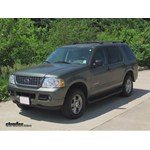
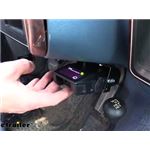
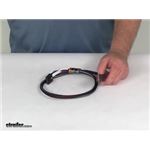
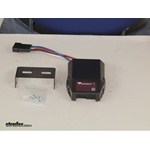
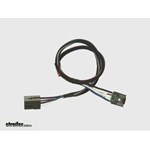

























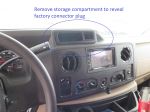


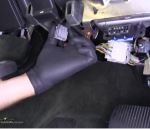




Thank you! Your comment has been submitted successfully. You should be able to view your question/comment here within a few days.
Error submitting comment. Please try again momentarily.